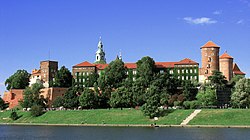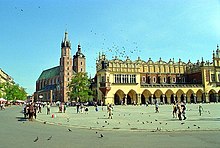Historic center of Krakow
| Historic center of Krakow | |
|---|---|
|
UNESCO world heritage |
|

|
|
| The Wawel Castle and former royal residence |
|
| National territory: |
|
| Type: | Culture |
| Criteria : | (iv) |
| Surface: | 149.65 ha |
| Buffer zone: | 907.35 hectares |
| Reference No .: | 29bis |
| UNESCO region : | Europe and North America |
| History of enrollment | |
| Enrollment: | 1978 ( session 2 ) |
| Extension: | 2010 |
Since 1978 the historical center of Krakow ( Polish Historyczne centrum Krakowa), the core of the former Polish capital Krakow in Lesser Poland , has been included in the list of UNESCO World Heritage .
This center is located on the Vistula (Wisła) under Castle Hill Wawel with the Royal Castle and the Wawel Cathedral . In addition to this Wawel Hill complex, the ensemble consists of the medieval core city of Krakow and the Kazimierz district with the suburb of Stradom . The merchant town of the 13th century has Europe's largest market square (Rynek Główny) and countless historic houses, palaces and churches with magnificent interiors. The city walls from the 14th century, the medieval district of Kazimierz with its old synagogues in the south, the Jagiellonian University and the Gothic cathedral in which the Polish kings are buried are further evidence of the fascinating past .
Three ensembles
The historic center of Krakow consists of the three urban ensembles as a World Heritage site :
- the medieval core city of Krakow,
- the Wawel Hill complex with castle and cathedral and
- the former city of Kazimierz with the suburb of Stradom .
The ensemble as a whole is one of the most remarkable examples of European urban planning, which is characterized by harmonious development and a collection of elements that represent all architectural styles from the early Romanesque to the modern.
meaning
The importance of the city, which received city rights in 1257 , is evident due to its urban layout, its numerous churches and monasteries, its imposing public buildings, the remains of the medieval city walls and because of its palaces and townhouses, many of which were designed and built by well-known architects and craftsmen were. The value of the urban ensemble is determined by the extraordinary density of monuments from different stylistic epochs , which have been preserved in their original form and with their authentic furnishings.
The dominant feature of the historical area of Krakow, Wawel Hill is a former royal residence and burial place that shows the dynastic and political connections during medieval and early modern Europe. The medieval town of Kazimierz (town charter since 1335), which also includes the suburb of Stradom, was shaped by the Catholic and Jewish faith and the associated culture and tradition.
As one of the largest administrative and trading centers in Central Europe, Krakow was a city of artists and successful craftsmen who combined the culture of East and West. This European importance as a cultural center was reinforced by the presence of one of the oldest universities with an international reputation, the Jagiellonian University. Together, these three districts or building complexes form a cohesive urban ensemble in which tangible and invisible heritage has survived and is maintained to the present day.
Criterion IV is therefore decisive, which was formulated for Krakow as follows:
Criterion (iv): Kraków is an urban architectural ensemble of outstanding quality, in terms of both its townscape and its individual monuments. The historic center of the town admirably illustrates the process of continuous urban growth from the Middle Ages to the present day.
(Krakow is an architectural ensemble of outstanding quality, both in terms of the urban landscape and the individual cultural monuments. The historic center of the city wonderfully illustrates the process of undisturbed urban development from the Middle Ages to the present.)
Integrity, authenticity and protection of the world heritage
The following properties of a World Heritage property are briefly summarized as follows:
Integrity
The historic center has a high degree of intactness, the ensemble has clear historical delimitations that include all elements of outstanding value that have remained intact and in good condition. The most important parts include above all the Wawel Hill with the castle and the cathedral, symbolizing the city's history as the seat of episcopal and royal power, and the medieval structures and historical pattern of the two originally separate cities, Krakow and Kazimierz. The scope of the ensemble is therefore of an appropriate size to show the importance of the ensemble in all its individual features and significant developments. And it has not suffered any negative development or neglect.
Authenticity
The historic center of Krakow is pristine and largely authentic. This is due to the location and structure, the architectural forms and decorations, the materials and their substance, and to a certain extent also to the use and function. The city topography in its location on the river and with the local castle hill has remained legible. The urban structure and functionality of the two cities, which Magdeburg was right , also brought the features into the urban fabric that have been preserved to this day. The city panorama has also remained intact, including the historic landmarks Wawelberg, City Hall Tower and individual churches. Modern influences in the cityscape have remained minimal and are located some distance from the old town. Many buildings and facilities have retained their original purpose for generations.
Protection of the world heritage

The historical center of Krakow, which is a mixture of public and private property, is protected in its entirety by law, the cultural monuments of the world heritage ensemble are protected by the entry in a "National Heritage Register", and the entire area has the President the Republic of Poland get the status of a “historical monument”, an additional protection. Since 2010 there has also been a buffer zone of around 900 hectares all around, which also serves to protect and preserve the ensemble.
The city has also made provisions for the management of the world heritage in its municipal monument protection program. The city administration with its own monument protection department and the state monument protection authority deal with the protection of monuments and have statutory supervision and intervention rights with regard to the world heritage.
A management plan for the World Heritage site and the buffer zone has yet to be incorporated into the overall urban planning so that protection becomes a goal of long-term urban planning and development.
literature
- Adam Bujak: Royal Krakow . Biały Kruk, Krakow 2005, ISBN 83-88918-77-X .
Web links
Individual evidence
- ^ English text of the entry in the Krakow list , accessed on July 2, 2018.
- ^ English text of the entry in the Krakow list , accessed on July 2, 2018.
Coordinates: 50 ° 3 '17.3 " N , 19 ° 56' 10.4" E





